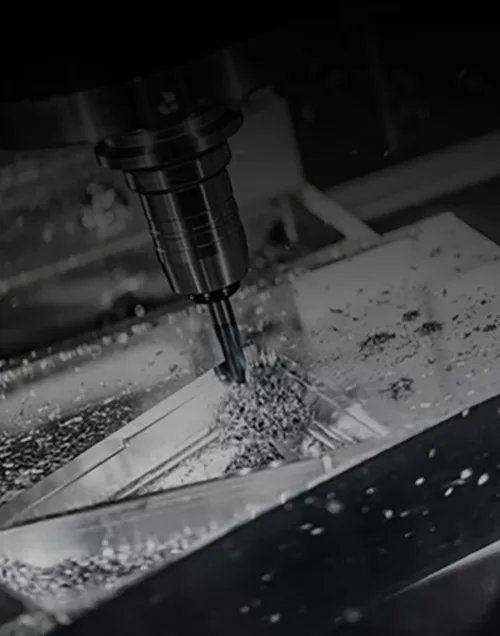In the world of precision manufacturing, achieving micron-level accuracy in CNC milling is not just a technological feat but a necessity for staying competitive. Whether you're producing aerospace components, medical implants, or high-end electronics, even the slightest deviation can compromise functionality and quality. This blog post delves into key strategies for optimizing CNC milling processes to ensure consistent, ultra-precise cuts every time.

Invest in High-Quality Equipment and Calibration
The foundation of micron-level accuracy lies in the machinery itself. Modern CNC milling machines equipped with high-resolution linear scales and advanced servo systems can achieve positioning accuracies down to 1-2 microns. For example, five-axis CNC mills offer multi-directional movement, reducing setup errors by machining complex geometries in a single operation. However, precision isn't static; regular calibration is crucial. Using laser interferometers and ball bar testers, manufacturers can detect and correct thermal expansion, backlash, and geometric errors, ensuring machines maintain peak performance over time.
Master Tooling Selection and Management
Cutting tools are the workhorses of CNC milling, and their quality directly impacts accuracy. Carbide end mills, for instance, provide excellent hardness and wear resistance for machining steels, while polycrystalline diamond (PCD) tools shine in finishing aluminum alloys. But tool selection is just the start. Effective tool management involves monitoring wear through in-machine sensors or post-cut inspections. As a tool dulls, it generates more heat and causes dimensional inaccuracies. By replacing tools proactively—even before visible wear—manufacturers can prevent costly errors and maintain consistent precision.
Optimize Process Parameters
The interplay between spindle speed, feed rate, and depth of cut is critical for achieving micron-level accuracy. High-speed milling reduces cutting forces and heat, minimizing workpiece deformation, especially for thin-walled parts. However, excessive speeds can cause tool chatter, degrading surface finish. Advanced CAM software can simulate these variables, predicting optimal settings based on material properties and geometry. For example, machining titanium alloys may require lower feed rates and higher spindle speeds to prevent work hardening and tool breakage. Additionally, coolant selection matters; high-pressure coolant systems can remove chips effectively, reducing friction and maintaining consistent temperatures.
Leverage Advanced Software Solutions
CAD/CAM software has revolutionized CNC milling by enabling precise toolpath generation and process simulation. Modern software allows designers to account for factors like tool deflection, stock removal rates, and machine limitations. For instance, algorithms can optimize toolpaths to reduce non-cutting movements, saving time while enhancing accuracy. Furthermore, real-time monitoring software integrated with CNC machines provides instant feedback on cutting conditions, allowing operators to make adjustments on the fly. Some systems even use artificial intelligence to analyze historical data and suggest process improvements, streamlining optimization efforts.
Implement Rigorous Quality Control Measures
Accuracy verification is essential at every stage of production. Coordinate Measuring Machines (CMMs) offer sub-micron measurement capabilities, enabling detailed inspections of finished parts against CAD models. Statistical Process Control (SPC) techniques, such as control charts, can identify trends and variations early, preventing batch failures. For example, if a CMM detects a gradual increase in dimensional deviation, manufacturers can trace the root cause—perhaps a worn spindle bearing or a software glitch—and take corrective action immediately.
In conclusion, achieving micron-level accuracy in CNC milling demands a holistic approach that combines top-tier equipment, intelligent tooling, optimized processes, advanced software, and vigilant quality control. As industries continue to demand smaller, more precise components, mastering these optimization strategies isn't just beneficial—it's essential for manufacturing excellence. By prioritizing precision at every step, businesses can elevate their capabilities, meet customer expectations, and gain a competitive edge in the global market.
 CapabilitiesPrototypes and production partsMechanical ManufacturingMechanical Manufacturing Capability: Excellent Craftsmanship, Creating Exceptional QualityParts Manufacturing and ProcessingParts Manufacturing and Processing: Meticulous Craftsmanship, Creating Premium PartsMaterial Surface FinishesMaterial Surface Finishes: Refining Processes, Reinventing Material ExcellenceInspection and Quality ControlInspection and Quality Control: Precise Control, Quality AssuranceHeat Treatment ServicesHeat Treatment Services: Precise Temperature Control, Reinventing Material ExcellencePrecision AssemblyPrecision Assembly: Meticulous Craftsmanship, Achieving Perfect Combinations
CapabilitiesPrototypes and production partsMechanical ManufacturingMechanical Manufacturing Capability: Excellent Craftsmanship, Creating Exceptional QualityParts Manufacturing and ProcessingParts Manufacturing and Processing: Meticulous Craftsmanship, Creating Premium PartsMaterial Surface FinishesMaterial Surface Finishes: Refining Processes, Reinventing Material ExcellenceInspection and Quality ControlInspection and Quality Control: Precise Control, Quality AssuranceHeat Treatment ServicesHeat Treatment Services: Precise Temperature Control, Reinventing Material ExcellencePrecision AssemblyPrecision Assembly: Meticulous Craftsmanship, Achieving Perfect Combinations IndustriesDeveloping revolutionary productsAutomotivePrecision Machining Services for Auto Parts in the Automotive Manufacturing IndustryMedical Equipment & HealthcarePrecision Medical Machining ServicesMilitary and AerospacePrecision Machining Services for Military and Aerospace ManufacturingElectronics and SemiconductorPrecision Machining Services for Electronics and Semiconductor ManufacturingEnergy and Industrial EquipmentPrecision Machining Services for Energy and Industrial Equipment Manufacturing
IndustriesDeveloping revolutionary productsAutomotivePrecision Machining Services for Auto Parts in the Automotive Manufacturing IndustryMedical Equipment & HealthcarePrecision Medical Machining ServicesMilitary and AerospacePrecision Machining Services for Military and Aerospace ManufacturingElectronics and SemiconductorPrecision Machining Services for Electronics and Semiconductor ManufacturingEnergy and Industrial EquipmentPrecision Machining Services for Energy and Industrial Equipment Manufacturing Metal MachiningProtoypes and production partsTitanium Alloy MachiningPrecision CNC Machining of Titanium MaterialsCopper and Aluminum MachiningPrecision CNC Machining of Copper and Aluminum AllStainless SteelMachiningPrecision CNC Machining of Stainless Steel MateriaDie Steel MachiningPrecision CNC Machining of Die Steel MaterialsComposite Material MachiningPrecision CNC Machining of Composite Materials
Metal MachiningProtoypes and production partsTitanium Alloy MachiningPrecision CNC Machining of Titanium MaterialsCopper and Aluminum MachiningPrecision CNC Machining of Copper and Aluminum AllStainless SteelMachiningPrecision CNC Machining of Stainless Steel MateriaDie Steel MachiningPrecision CNC Machining of Die Steel MaterialsComposite Material MachiningPrecision CNC Machining of Composite Materials Plastic MachiningProtoypes and production parts
Plastic MachiningProtoypes and production parts
